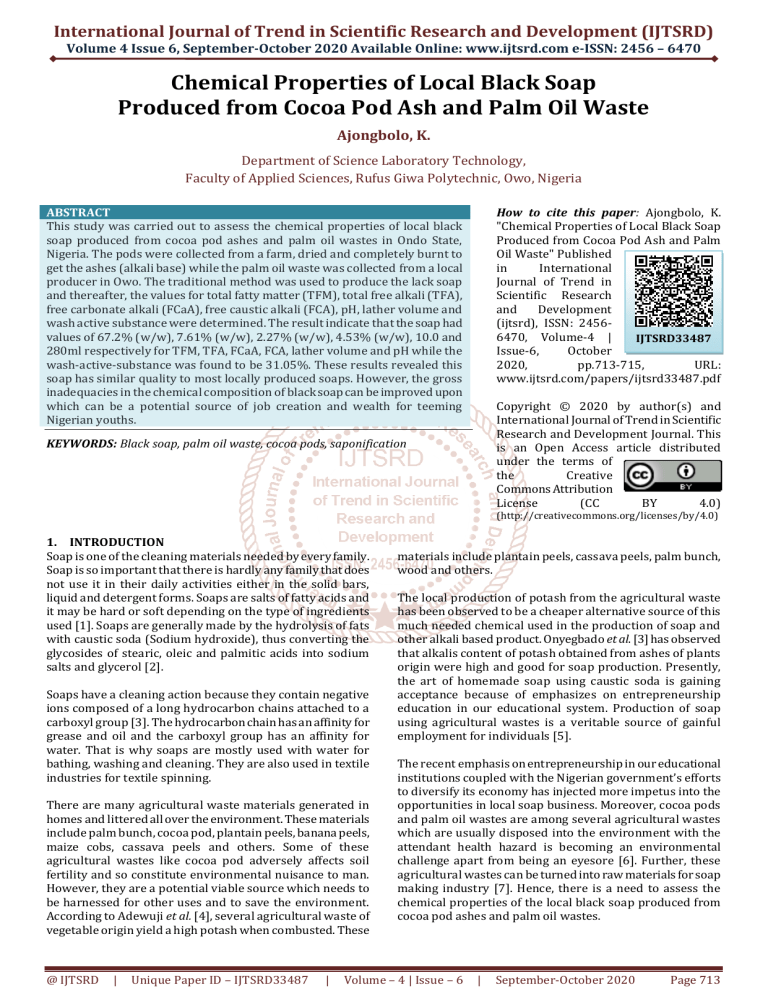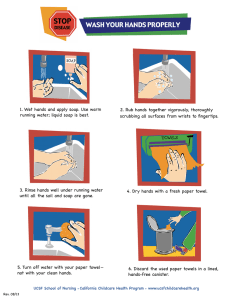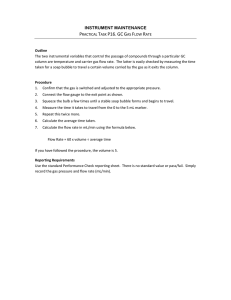
International Journal of Trend in Scientific Research and Development (IJTSRD)
Volume 4 Issue 6, September-October 2020 Available Online: www.ijtsrd.com e-ISSN: 2456 – 6470
Chemical Properties of Local Black Soap
Produced from Cocoa Pod Ash and Palm Oil Waste
Ajongbolo, K.
Department of Science Laboratory Technology,
Faculty of Applied Sciences, Rufus Giwa Polytechnic, Owo, Nigeria
ABSTRACT
This study was carried out to assess the chemical properties of local black
soap produced from cocoa pod ashes and palm oil wastes in Ondo State,
Nigeria. The pods were collected from a farm, dried and completely burnt to
get the ashes (alkali base) while the palm oil waste was collected from a local
producer in Owo. The traditional method was used to produce the lack soap
and thereafter, the values for total fatty matter (TFM), total free alkali (TFA),
free carbonate alkali (FCaA), free caustic alkali (FCA), pH, lather volume and
wash active substance were determined. The result indicate that the soap had
values of 67.2% (w/w), 7.61% (w/w), 2.27% (w/w), 4.53% (w/w), 10.0 and
280ml respectively for TFM, TFA, FCaA, FCA, lather volume and pH while the
wash-active-substance was found to be 31.05%. These results revealed this
soap has similar quality to most locally produced soaps. However, the gross
inadequacies in the chemical composition of black soap can be improved upon
which can be a potential source of job creation and wealth for teeming
Nigerian youths.
How to cite this paper: Ajongbolo, K.
"Chemical Properties of Local Black Soap
Produced from Cocoa Pod Ash and Palm
Oil Waste" Published
in
International
Journal of Trend in
Scientific Research
and
Development
(ijtsrd), ISSN: 24566470, Volume-4 |
IJTSRD33487
Issue-6,
October
2020,
pp.713-715,
URL:
www.ijtsrd.com/papers/ijtsrd33487.pdf
Copyright © 2020 by author(s) and
International Journal of Trend in Scientific
Research and Development Journal. This
is an Open Access article distributed
under the terms of
the
Creative
Commons Attribution
License
(CC
BY
4.0)
KEYWORDS: Black soap, palm oil waste, cocoa pods, saponification
(http://creativecommons.org/licenses/by/4.0)
1. INTRODUCTION
Soap is one of the cleaning materials needed by every family.
Soap is so important that there is hardly any family that does
not use it in their daily activities either in the solid bars,
liquid and detergent forms. Soaps are salts of fatty acids and
it may be hard or soft depending on the type of ingredients
used [1]. Soaps are generally made by the hydrolysis of fats
with caustic soda (Sodium hydroxide), thus converting the
glycosides of stearic, oleic and palmitic acids into sodium
salts and glycerol [2].
Soaps have a cleaning action because they contain negative
ions composed of a long hydrocarbon chains attached to a
carboxyl group [3]. The hydrocarbon chain has an affinity for
grease and oil and the carboxyl group has an affinity for
water. That is why soaps are mostly used with water for
bathing, washing and cleaning. They are also used in textile
industries for textile spinning.
There are many agricultural waste materials generated in
homes and littered all over the environment. These materials
include palm bunch, cocoa pod, plantain peels, banana peels,
maize cobs, cassava peels and others. Some of these
agricultural wastes like cocoa pod adversely affects soil
fertility and so constitute environmental nuisance to man.
However, they are a potential viable source which needs to
be harnessed for other uses and to save the environment.
According to Adewuji et al. [4], several agricultural waste of
vegetable origin yield a high potash when combusted. These
@ IJTSRD
|
Unique Paper ID – IJTSRD33487
|
materials include plantain peels, cassava peels, palm bunch,
wood and others.
The local production of potash from the agricultural waste
has been observed to be a cheaper alternative source of this
much needed chemical used in the production of soap and
other alkali based product. Onyegbado et al. [3] has observed
that alkalis content of potash obtained from ashes of plants
origin were high and good for soap production. Presently,
the art of homemade soap using caustic soda is gaining
acceptance because of emphasizes on entrepreneurship
education in our educational system. Production of soap
using agricultural wastes is a veritable source of gainful
employment for individuals [5].
The recent emphasis on entrepreneurship in our educational
institutions coupled with the Nigerian government’s efforts
to diversify its economy has injected more impetus into the
opportunities in local soap business. Moreover, cocoa pods
and palm oil wastes are among several agricultural wastes
which are usually disposed into the environment with the
attendant health hazard is becoming an environmental
challenge apart from being an eyesore [6]. Further, these
agricultural wastes can be turned into raw materials for soap
making industry [7]. Hence, there is a need to assess the
chemical properties of the local black soap produced from
cocoa pod ashes and palm oil wastes.
Volume – 4 | Issue – 6
|
September-October 2020
Page 713
International Journal of Trend in Scientific Research and Development (IJTSRD) @ www.ijtsrd.com eISSN: 2456-6470
2. MATERIALS AND METHODS
2.1. Collection of cocoa pods and palm oil waste
Freshly harvested cocoa pods were sourced from cocoa
plantation in Iyere, Owo, Ondo state. They were sundried for
four weeks and packed in jute bags until needed. Palm oil
residue used for this research was obtained from Emure-Ile
local palm oil, Owo local government, Ondo state and was
transported to the Laboratory for further use.
2.2. Extraction of Alkali from cocoa pods
The sun dried cocoa pods were burnt properly to form ash
which lasted for about 8 hour. The ashed sample was
homogenized by crushing between fingers and then sieved
with analytical sieve to obtain uniform particles size. About
300 g of the ash was placed in a 3 litre container and 2 litre
of distilled water was added. The mixture was placed on a
stove and boiled continuously for 4 hour. After which it was
allowed to stand for 48 hour and the content was filtered
using muslin cloth to obtain clearer extract. The filtrate was
allowed to boil further to concentrate it.
2.3. Production of black soap
The traditional method for producing black soap was
adopted. 1000 ml of oil extracted from palm oil waste was
placed in a stainless steel pot and heated strongly and 500
ml of the derived concentrated alkali solution was gradually
discharged into the pot and stirred until the mixture became
thickened. The heating continued for about 30min with
continuous stirring. The pot with its content was removed
from the fire and allowed to cool. The soap was allowed to
cure overnight before removing the soap cake.
2.4.
Determination of physico-chemical properties of
the black soap produced from cocoa pod ash
2.4.1. Determination of Total Fatty Matter (TFM)
The soap sample (5g) was dissolved in 50ml-distilled water
and the volume adjusted to 10ml, it was then boiled for
about 30min, after which the solution was allowed to cool
and then made acidic with 0.1m sulphric acid. The solution is
then extracted with 50ml diethyl ether and then with
another three-25ml portions of diethyl ether. The combined
ether extracts was filtered into a tarred 250ml flask and the
ether evaporated. The weight of the total fatty matter is
obtained by subtracting the weight of the ether extracts form
initial weight of the soap sample [8].
2.4.2. Determination of Total Free Alkali (TFA)
10g of soap sample were digested in freshly boiled ethanol
(200ml) on steam bath until the soap sample was dissolved.
The solution was heated to boiling and then filtered with
standard 0.1m sulphuric acid to phenolphthalein and point.
The total free alkali is calculated as potassium oxide using
the relationship weight (g) of:
TFA = molarity of acid X formula weight of oxide X volume
of acid used (liters).
2.4.3. Determination of Free Caustic Alkali (FCA)
10g of soap were dissolved in 100ml of neutralized ethanol
over steam bath and 10ml of barium chloride added to the
hot solution. The soap sample is filtrated with0.1m sulphuric
acid using phenolphthalein indicator [9]. The amount of free
caustic alkali in the soap is calculated using the relationship
as;
FCA = molarity of acid X formula weight of barium
chloride X volume of acid used (liters).
@ IJTSRD
|
Unique Paper ID – IJTSRD33487
|
2.4.4. Determination of Free Carbonate Alkali
Free carbonate is determined by subtracting the free caustic
alkali from total free alkali that is:
Free carbonate alkali = TFA-FCA
2.4.5. Determination of Wash-Active-Substance (WAS)
50g of the soap sample was digested in freshly boiled
ethanol (300ml). The solution was refluxed for 75 minutes
over steam bath and then allowed to settle down. 1%
ethanol phenolphthalein (2-4 drops) was added. The
solution was filtered and the resulting precipitate was
washed with ethanol (50ml) into the flask and then boiled
and filtered as before into the flask containing the filtrates.
The washings were repeated five times. The combined
filtrates were evaporated to dryness over the steam bath and
residue was dried in an oven at 105ºC until constant weight.
The paste obtained is the W.A.S. [10].
2.4.6. Determination of pH
The pH of the sample was determined using Geirincharz
thermos pH meter, 10g of the sample was weighed into a
beaker and then 100ml of distilled water was added and
agitated to dissolve the sample. The pH meter was
standardized at pH 7 according to user’s manual. The
electrodes were placed in the sample solution then pH was
recorded.
3. RESULTS AND DISCUSSION
Cocoa pod soap was prepared as a product of saponification
reaction between palm oil and POH solution extracted from
cocoa pod ash. The soap free caustic alkali value (2.27%)
compares well with the standard literature value. The free
caustic alkali is the amount of alkali free to prevent soap
from becoming oily [11]. Moreover, the detected free caustic
alkali content of the soap is in harmony with the results
obtained by earlier researchers [2, 5, 12].
Table 1: Chemical properties of black soap produced
from cocoa pod ash and palm oil waste
Parameter
Value
Total fatty matter
67.2%
Total free alkali
7.61%
Free caustic alkali
2.27%
Free carbonate alkali
4.53%
Lather volume
280 ml
Wash active substance 31.05%
pH
10.2
The Wash Active Substance (WAS) obtained for the cocoa
pod oil was 31.05% which is similar to the value obtained by
Ikotun et al. [13]. This property is believed to make cocoa
pod float on the surface of water when dropped in water. It
was based on this property that makes it easier to collect
cocoa pod on the surface of water during the extraction [14].
The Total Free Alkaline (TFA) value was found to be 7.6 %
for black soap made from cocoa pod ash. This value falls
within the range reported in literature which was 3-8 %
[15]. This means that the palm oil waste can be used for
saponification without refining [16].
The Total Fatty Matter (TFM) of cocoa pod black soap was
67.2 % which was found to be in range with the standard
literature value (67 – 77 %) [17]. The lower TFM value may
be due to the presence of unreacted POH in the mixture.
Volume – 4 | Issue – 6
|
September-October 2020
Page 714
International Journal of Trend in Scientific Research and Development (IJTSRD) @ www.ijtsrd.com eISSN: 2456-6470
These differences in the TFM may be responsible for high
moisture contents and the quantities of the used fatty
materials and also perhaps due to the difference in the
saponification method. This re-hydrates the skin making it
smooth and additionally the high oil content within the soap
acts as a lubricant throughout the day [18]. This property
makes it ideal medicinal soap for people in the tropics.
[7] C. I. Beetseh, and M. K. Anza, “Chemical
characterization of local black soap (chahul mtse)
made by using cassava peels ashes (alkali base) and
palm oil in North Central Zone of Nigeria.” Civ. Environ.
Res. Vol 3(4) pp 82-91, 2013.
The lather volume (ml) of cocoa pod soap was determined
by measuring height of foam formed by the soap with pure
water [19]. The lather volume observed in this study was
280 ml which compared well with those obtained from
literature. This observation corroborates moisture loss, that
is, as the moisture content reduces, the corresponding
foaming strength increases [16].
[9] A. O. Kuye, and C. Okorie C. “Factors Affecting The
Lixiviation of Palm Bunch Ash As A Source of Alkali For
Soap Production” Ife Journal of Technology vol 3 (2) pp
33-37, 1990.
From the results, the pH (10.2) of the black soap produced
from cocoa pod ash was consistent with the normal pH range
for soap 9-11 [20]. This low value obtained might be due to
partial alkali hydrolysis resulting from the saponification
process. The reaction can be completed by the addition of
excess cocoa pod oil or any other super fatting agent to
reduce the severe nature of the soap or addition of excess
caustic soda [19]. The prepared soap may not be corrosive to
the skin since it was made of a salt of a weak acid (fatty acid)
and a strong base (POH). The soap was alkaline in aqueous
media. Literature had shown that alkaline substances
neutralize the body’s protective acid mantle that acts as a
natural barrier against bacteria and viruses [21]. Therefore,
there is a need to modify the soap to make the pH more skin
friendly to protect the user’s skin microflora.
CONCLUSION
The data obtained on black soap in this study shows that it
can compete favorably with other soaps. The apparent
deviation is probably due to its crude nature and that of raw
materials. Colorants may be used to improve its aesthetic
value via desired coloration of the soap. Also, the soap pH
may be adjusted with to neutral for the protection of the
skin.
References
[1] S. Alfred, “Soap manufacture and Soap” Commerce
Pharmaceutical Journal. vol 14, pp 1883 – 1884, 1983.
[2] C. O. Onyegbado, E. T. Iyagba, and O. J. Okafor, “Solid
Soap Production using Plantain peels ash as source of
alkali” Journal of Applied Sciences and Environmental
Management vol 6(1), pp 73-77, 2015.
[3] K. M. Dunn, Scientific Soap making: The Chemistry of
Cold Process. Clavicula Press, 2010
[4] G. O. Adewuyi, N. O. Sbi-Egbedi, and J. O. Babayemi,
“Evaluation of ten different wood Species for potash
production,” International Journal of Physical Science
vol 3(3), pp 63-68, 2008.
[5] O. E. Taiwo, and F. A. O. Osinowo, “Evaluation of
various agro-wastes for traditional soap production”
Bioresource Technology vol 79(1), pp 95-97, 2001.
[6] D. Adeloye, Production Encyclopedia for Self
Employment and Investment by Soap Production. pp 48, 2002.
@ IJTSRD
|
Unique Paper ID – IJTSRD33487
|
[8] B. T. Getradeghana, “Evaluation of African traditional
soap.” Glob. J. Pure Appl. Sci. vol 6 pp 174-179, 2000.
[10] A. M. Oyekanmi, O. R. Adebayo, and A. G. Farombi
“Physiochemical Properties of African Back Soap, and
It’s Comparison with Industrial Black Soap” American
Journal of Chemistry vol 4(1) pp 35-37, 2014.
[11] A. A. Ikotun, O. O. Awosika, and M. A. Oladipo, “The
African black soap from Elaeis guineensis (Palm kernel
oil) and Theobroma cacao (Cocoa) and its transition
metal complexes” African Journal of Biotechnology Vol.
16(18), pp. 1042-1047, 2017a
[12] A. O. Edahn, C. B. Nnoli and D. F. Wetkum
“Physicochemical Properties and Anti-Microbial
Activity of Local Black Soap and Its Comparison with
Ghana Soap with Respect to Nigerian Industrial
Standard.” African Research Journal of Chemistry pp 814, 2017.
[13] A. A. Ikotun, C. A. Olalere, D. O. Adekunle and M. O.
Dawodu, “Phytochemistry and Antimicrobial Studies of
African Black Soap and its Modified Samples.” Journal
of Chemical and Pharmaceutical Research vol 9(5) pp
354-359, 2017b.
[14] C. Onyekwere, (1996). Cassava peels Ash: An
alternative source of alkali in soap production B. Eng.
Thesis Department of Chemical Engineering University
of Port-Harcourt, Nigeria pp 1-33, 1996.
[15] J. Tarun, J. Susan, J. Suria, V. J. Susan, and S. Criton.
“Evaluation of pH of Bathing Soaps and Shampoos for
Skin and Hair Care.” Indian Journal of Dermatology vol
59(5) pp 442-444, 2014.
[16] H. O. Ogunsuyi and C. A. Akinnawo, “Quality
Assessment of Soaps Produced from Palm Bunch AshDerived Alkali and Coconut Oil” J. Appl. Sci. Environ.
Manage. Vol. 16 (4) 363-366, 2012.
[17] G. Afrane, “Learning of caustic potash from coco
huskash” Bioresouce Technology vol 41(2) pp 101-104,
1992.
[18] K. Schuman and K. Siekman, Soaps in Ullmann’s
encyclopedia of industrial chemicals, 2005.
[19] A. O. Kuye, and C. Okorie, “Factors Affecting The
Lixiviation of Palm Bunch Ash As A Source of Alkali For
Soap Production” Ife Journal of Technology vol 3 (2) pp
33-37, 1990.
[20] O.
Bella,
“African
Black
Soap”,
http://www.bellaonline.com/articles/art26846.asp,
2008.
[21] K. R. Onifade, “The potential Application of Cocoa pod
husks for the manufacture of caustic potash” Journal of
Agricultural Technology viol 2 (2) pp 59-64, 1994.
Volume – 4 | Issue – 6
|
September-October 2020
Page 715



